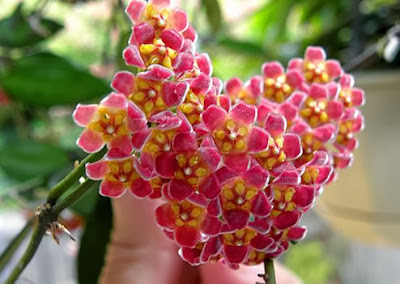Type of Flowers
Hoya:
Hoya is an Asclepiad genus of 200–300 species of tropical plants in the family Apocynaceae (Dogbane). Most are native to Asia including India, China, Thailand, Malaysia, and Indonesia, There is a great diversity of species in the Philippines, and species in Polynesia, New Guinea, and Australia.
Common names for this genus are waxplant, waxvine, waxflower or simply hoya. This genus was named by botanist Robert Brown, in honour of his friend, botanist Thomas Hoy.
Hoya flowers are all shaped like five pointed stars. Some of the species' petals reflex so far that the flowers appear to be round or ball-like. They grow in umbels, or in some species singly. Umbels can reach impressive proportions in some species, and many species have individual flowers well over three inches in diameter (H. imperialis Lindl., H. lauterbachii K. Schuman). H. coriacea Blume has been known to have as many as 70 in an inflorescence, each individual measuring nearly 2 cm in diameter with the umbels over 30 cm in breadth. The single-flowered Hoya pauciflora Wight makes up for its paucity by its flower size of nearly an inch and a half in diameter produced at any time of year. Textures of flower surfaces may be glabrous and shiny, to matte, to finely haired, and some being quite hairy. One of the two clones of Hoya mindorensis Schltr., from the Philippines, comes very close to being a true red. Blue, purples, and violets do not appear to be represented in the genus Hoya.
Many species of Hoya are popular houseplants in temperate areas (especially H. carnosa), grown for their attractive foliage and strongly scented flowers. Numerous cultivars have been selected for different leaf forms or flower colours. Hoyas grow well indoors, preferring bright light, but will tolerate fairly low light levels, although they may not flower without bright light. Hoyas commonly sold in nurseries as houseplants include cultivars of H. carnosa (Krimson Queen, Hindu Rope − compacta), H. pubicalyx (often mislabelled as H. carnosa or H. purpurea-fusca), and H. kerrii. Hoyas are easy to propagate, and are commonly sold as cuttings, either rooted or unrooted, or as a potted plant.
Hoyas are evergreen perennial creepers or vines or rarely, shrubs. They often grow epiphytically on trees; some grow terrestrially, or occasionally in rocky areas. They climb by twining, and with the employment of adventitious roots. Larger species grow 1–18 m (3–59 ft), or more, with suitable support in trees. They have simple entire leaves, arranged in an opposite pattern, that are typically succulent. Leaves may exhibit a variety of forms, and may be smooth, felted or hairy; veination may be prominent or not, and many species have leaf surfaces flecked with irregular small silvery spots.




















No comments:
Post a Comment